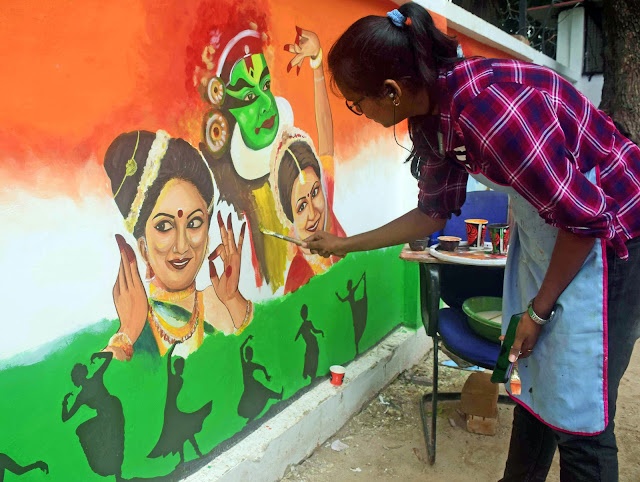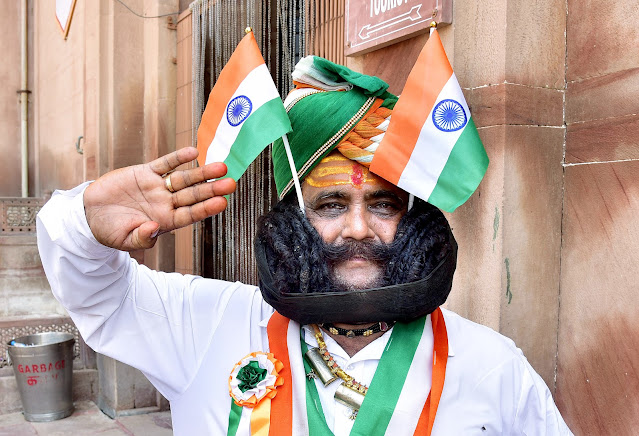India at 75 – evolution of the national flag
 |
| An art student gives final touches to a wall painting to celebrate India’s Independence Day, in Prayagraj (Allahabad), a city in the northern Indian state of Uttar Pradesh. | ANI Photo |
Every country has stories to tell, paths of history that it has walked on, and foundations upon
which its future is built. A country’s flag, is a symbol of its freedom and identity, and its inherent value systems – the Indian tricolour encapsulates them all.
Let’s unfurl the story of the Indian national flag as the largest democracy in the world celebrates the 75th anniversary of its Independence on August 15. The national flag of India was adopted at the meeting of the Constituent Assembly, held on July 22, 1947, just before the country’s Independence from British rule. The ‘tricolour’, first the national flag of the Dominion of India between August 15, 1947 and January 26, 1950; that of the Republic of India thereafter.
The Indian flag went through metamorphoses over the centuries. It was after the rebellion (also known as the first war of Independence) in 1857 the first flag was raised by the British. The design was similar to the flags of their other colonies. Red in colour, it included the Union Jack in the upper-left quadrant and a Star of India capped by the royal crown in the middle of the right half.
The tricolour flag included eight white lotuses on the upper green band representing the eight provinces, a sun and a crescent on the bottom red band, and the Vande Mataram slogan in Hindi on the central yellow band. The flag was launched in Calcutta. At each point of India’s history, the design of the flag was representative of that era.
THE TRICOLOUR
 |
| Girdhar Vyas, claiming have the longest moustaches in the world, poses with the National flags as part of the 75th Independence Day celebrations, in the western Indian city of Bikaner. | ANI Photo |
The national flag of India is a horizontal tricolour of deep saffron at the top, white in the middle, and dark green at the bottom in equal proportion. The ratio of width of the flag to its length is two to three. In the centre of the white band is a navy blue wheel, which represents the chakra.
Its design is that of the wheel, with 24 spokes, which appears on the abacus of the Sarnath Lion Capital of Ashoka – which is the national symbol of India.
The saffron colour represents strength and courage of the country, the white middle personifies peace and truth, with the Dharma Chakra (wheel of law), and the at the bottom, green signifies fertility, growth, and auspiciousness of the land.
 |
| An autorickshaw (tuk tuk) passes the illuminated Vidhan Bhavan (Assembly House) in the northern India city of Lucknow, capital of Uttar Pradesh. | ANI Photo |
The Dharma Chakra, which is symbolic predominantly in Buddhism, was made by the Mauryan Emperor Ashoka in third century BC. The chakra depicts that there is life in movement and death in stagnation. The Indian tricolour personifies the value systems that have evolved and continue to inspire generations – truth, righteousness, humility, peace, and universal brotherhood. India earned freedom on the sacrifices of millions of people, some of them who even laid down their lives in the hope to see their country free from the British rule. The flag, in whatever variant, was a symbol of courage for these freedom fighters, most who did not live to breathe in free India. Their sacrifices did not go in vain – even with the trials and tribulations India, as a young independent nation, has thrived.
Mahatma Gandhi once said: “My religion is based on truth and non-violence. Truth is my God. Non-violence is the means of realising Him.” Let peace and happiness be our religion, too.
Happy 75th, India!
.png)



Comments
Post a Comment